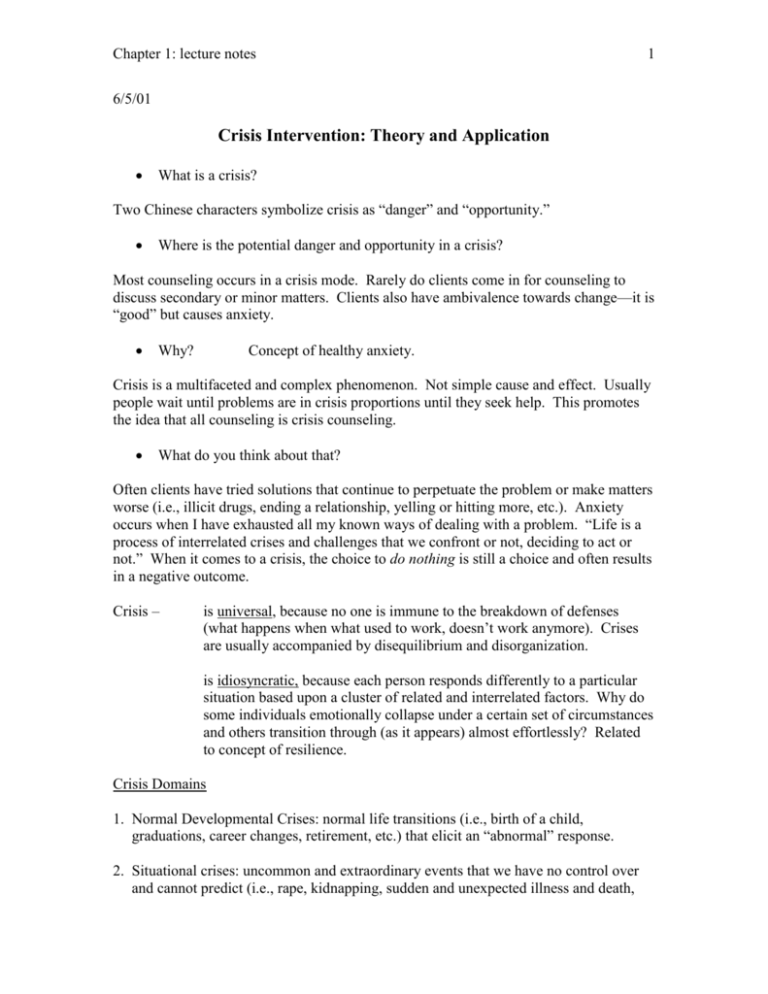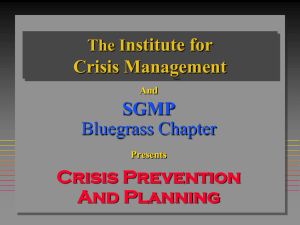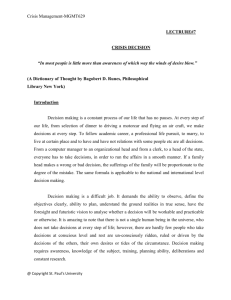Crisis Intervention: Theory and Application
advertisement

Chapter 1: lecture notes 1 6/5/01 Crisis Intervention: Theory and Application What is a crisis? Two Chinese characters symbolize crisis as “danger” and “opportunity.” Where is the potential danger and opportunity in a crisis? Most counseling occurs in a crisis mode. Rarely do clients come in for counseling to discuss secondary or minor matters. Clients also have ambivalence towards change—it is “good” but causes anxiety. Why? Concept of healthy anxiety. Crisis is a multifaceted and complex phenomenon. Not simple cause and effect. Usually people wait until problems are in crisis proportions until they seek help. This promotes the idea that all counseling is crisis counseling. What do you think about that? Often clients have tried solutions that continue to perpetuate the problem or make matters worse (i.e., illicit drugs, ending a relationship, yelling or hitting more, etc.). Anxiety occurs when I have exhausted all my known ways of dealing with a problem. “Life is a process of interrelated crises and challenges that we confront or not, deciding to act or not.” When it comes to a crisis, the choice to do nothing is still a choice and often results in a negative outcome. Crisis – is universal, because no one is immune to the breakdown of defenses (what happens when what used to work, doesn’t work anymore). Crises are usually accompanied by disequilibrium and disorganization. is idiosyncratic, because each person responds differently to a particular situation based upon a cluster of related and interrelated factors. Why do some individuals emotionally collapse under a certain set of circumstances and others transition through (as it appears) almost effortlessly? Related to concept of resilience. Crisis Domains 1. Normal Developmental Crises: normal life transitions (i.e., birth of a child, graduations, career changes, retirement, etc.) that elicit an “abnormal” response. 2. Situational crises: uncommon and extraordinary events that we have no control over and cannot predict (i.e., rape, kidnapping, sudden and unexpected illness and death, Chapter 1: lecture notes 2 layoffs or corporate buyouts, a plunge in the stock market, etc.). “These types of crises are different from all others in that they are sudden, shocking, intense and often catastrophic.” 3. Existential Crises: inner conflict and anxiety around existential concerns (i.e., time running out, responsibility, choice and accountability, freedom, lack of meaning, etc.). A void remains that cannot be filled in a meaningful way. 4. Environmental Crises: Natural or human-caused disasters, often occurring to individuals and groups of people (hurricanes, tornadoes, earthquakes, blizzards-others include disease epidemics, war, ethnic cleansing, severe economic depression. “Crises are usually time-limited and persist for a maximum of six to eight weeks at which time the subjective discomfort diminishes.” Transcrisis: the original crisis event becomes submerged into the unconscious and re-emerges when anxiety is re-experienced. A woman who experienced rape will re-experience problems with being sexually intimate with a man and experience problems in intimate relationships. Transcrisis points are stressful situations a person encounters after the crisis that perpetuate the original trauma—“psychological aftershocks.” Theories of Crisis and Crisis Intervention No one theory is more valid than another or serves as the ultimate model in dealing with Crisis victims. Development of theory: Emerging from psychoanalytic theory, Basic Crisis Intervention helped professionals and paraprofessionals identify crisis situations in those manifesting “pathological” symptoms. Previous to this, clients were labeled as abnormal. Lindeman and Caplan noted that crisis was transitory and was accompanied by normal grief responses. (Accompany “loss”): Preoccupation with the lost one Identification with the lost one Expressions of guilt and hostility Some disorganization in daily routine Some evidence if somatic complaints Out of this theory, clinicians were encouraged to intervene in ways to eliminate the “affective, behavioral and cognitive distortions that precipitated the psychological trauma in the first place.” What makes a situation a crisis situation depends on “how intensely the client views the problem as intolerable or how much emotional disequilibrium the client experiences.” Chapter 1: lecture notes 3 Brief therapy is problem-focused; crisis intervention is focused on the disequilibrium, disorganization and subjective distress the client manifests. Limits to basic theory—didn’t take into account the environmental and other factors that contribute to the trauma of a crisis. Led to development of Expanded Crisis Theory: Which draws upon other disciplines to explain other forces affecting crisis: Psychoanalytic Theory: Disequilibrium occurs because of something suppressed in the person’s unconscious or past emotional experiences. Systems Theory: In the realm of family counseling—focus not on the crisis but on how members of the person’s system respond to the crisis and the individual’s response to the crisis. “. . .refers to an emotional system, a system of communications, and a system of need fulfillment and request” in which all members within an intergenerational relationship bring something to bear on the others and each drives something from the others. p. 11 Adaptational Theory: The crisis is “sustained through maladaptive behaviors, negative thoughts and destructive defense mechanisms.” The basic premise is that the crisis will recede when the person learns more adaptive ways of dealing with the crisis. Interpersonal Theory: Rogerian in origin, based on the premise that people cannot sustain a personal state of crisis for very long if they believe in themselves and in others and have the confidence that they can become self-actualized and overcome the crisis. Relationship facilitating skills are essential in this theory. Chaos Theory: Originally the purview of physical sciences, it refers to systems or events that appear random, but at a closer look reveal an underlying global order. It is seen as evolutionary and relies on the following points: 1) regarding human behavior, in the sate of chaos, predictability is lost; 2) systems whose complexity and dynamics appear chaotic at the local level, when observed on a global level may show an underlying order; 3) equating chaos with a state of overwhelming anxiety, defined as an acute apprehension and fear, usually marked by physiological signs, chaos is considered to offer potential for intrapsychic growth and change. p. 11 When individuals experience “emergent complex messiness” they move into a “selforganizing mode” which may include a critical mass of people to attempt to solve the problem. The messiness of the crisis lies not in disorder but in an order that is unknown, unpredictable and spontaneous, an ever-shifting pattern driven by millions of uncoordinated, independent factors that necessitate experimentation yet may finally result in a global clarification of the crisis. Such experimentation my lead Chapter 1: lecture notes to false starts, temporary failure, dead ends, spontaneous innovation, creativity, improvisation, brainstorming, cooperative enterprise, and other “evolutionary” attempts to make sense of and cope with a crisis. p. 12 Example of Francine Shapiro and EMDR. Chaos theory brings to light the Chinese symbols of “danger” and “opportunity.” Ecosystem theory Electronic Media Impact: We have become a global community because of extensive and extended media coverage of natural disasters, war and violence. These images have ripple effects that extend far beyond the immediate victims of those events. Media have ways of keeping us in a continual state of agitation. Systemic Interdependency: A Macrosystemic Approach: Crisis Intervention Models The Equilibrium Model: The Cognitive Model: The Psychosocial Transition Model: Eclectic Crisis Intervention Theory Characteristics of Effective Crisis Workers Life Experiences: Professional Skills: Poise: Creativity and Flexibility: Energy: Quick Mental Reflexes: Other Characteristics: 4 Chapter 1: lecture notes Crises and the Personhood of Crisis Workers Multicultural Perspectives in Crisis Intervention 5





